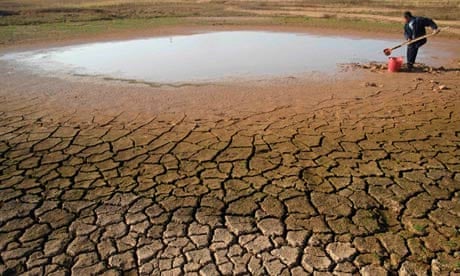The role of multinational buyers in shaping ecosystems and livelihoods of communities, through ethical and environmental procurement policies, is widely recognised. In response, there has been growing pressure on purchasers of agricultural products from developing countries to embrace ethical sourcing strategies.
A less discussed, but equally significant aspect of supply chain management, is the threat that climate change will have on the availability of certain products. As today's traditional sources of supply come under threat, companies will increasingly have to review existing sources and develop alternatives to satisfy demand.
Take coffee, tea, cocoa, or grapes. Such commodities will only grow successfully if rainfall, climate and soil conditions are just right. One effect of climate change is that the key growing areas for these, and other crops, may become less suitable, with other areas coming to the fore.
A growing body of research is looking to understand how climate change is affecting conditions for different crops and how producers and the food industry can adapt to inevitable changes. For example, a study by the Centre for International Tropical Agriculture (CIAT) found that many of the prime tea producing areas of Kenya are likely to become less suitable over the next 20 to 30 years.
However, climate change is only one part of the supply chain equation, and other environmental and social factors are combining to alter the spatial viability of crops. Socio-economic changes, such as migration, land encroachment from urban sprawl and competition for water resources are affecting the ability of certain areas to maintain the necessary level of human and capital investment in agricultural production. Migration, for example, can have unexpected results – draining the potential workforce at critical times for pest and disease control and yet providing remittances to rural households that may be invested in other activities such as livestock, are often seen as a convenient form of savings.
This shifting of suitable production zones will be a significant challenge for producers, processors and purchasers. Currently, to ensure long-term stability of supply from key areas, large food, beverage and fibre companies invest in transport and social infrastructure, building goodwill among local communities, which can help to ensure a long-term, secure supply. Such investments appear more risky and uncertain if long-term climate trends and production outlooks are poorly understood.
Greater uncertainty is itself a barrier to investment and that lack of investment can further undermine the viability of key production areas to deliver reliable, suitable quality products.
Against this backdrop, what do global commodity purchasers currently do to mitigate such risks? The short answer is not much, as supply chain management in recent years has been dominated by a questionnaire-based approach to data gathering. This would typically see procurement departments ask potential suppliers to answer a series of questions related to topics, such as fertiliser and pesticide use, labour standards and energy usage, and if the replies are deemed suitable, the supplier is approved.
This is all very well when seeking some basic reassurance on management competency and social safeguards, but fails to address the strategic issues of reliability of supply.
However, some groups are starting to respond. A good example is the Ethical Tea partnership, which has recently begun working with a range of scientific, producer organisations and buyers to understand the nature of the challenge and how effective responses can be mounted.
The increasing availability of data from satellites offers one way to reduce or at least understand these uncertainties. Satellite sensors can now measure changes in crop productivity, crop types and underlying environmental conditions. Socio-economic and technical changes, such as increased mechanisation, irrigation and cultivation methods, can also be observed or inferred from satellite data.
The first Earth observation satellite, LandSat 1 was launched in July 1972 and since then the LandSat programme, funded by the US government, has continuously collected information on a range of climatic and environmental variables. Landsat 8 has just been successfully launched and should begin transmitting data within a few months. The European Space Agency (ESA) is shortly to launch its Sentinel constellation that will further expand the repertoire of available wavelengths and time periods available for analysis.
With greater access to detailed data, or resolution, the critical question is how such information can be harnessed to help businesses understand the impacts of climate change?
Significant innovation is currently taking place in this area, which will help users understand and interpret climate data. Harnessing data and maps derived from satellite feeds, users can access data on carbon stocks, water security and biodiversity for areas of significance to their sourcing strategy. The availability of monthly updates on climate variables from Nasa is shortly set to allow businesses to gather information on long-term climactic trends. Such insight can be used to decide where to source products from, where to invest in supply chain infrastructure and where communities may be at greater risk from poor harvests.
The challenges facing supply chain professionals are unlikely to recede, as climate change affects an ever-increasing number of sourcing strategies. In response, international buyers must take steps to ensure they address such risks by securing the information required to understand, manage and, ultimately, minimise the risk of disruptions to their supply chain.
Richard Tipper is chief executive of Ecometrica, a provider of geospatial environmental information, and David Jarrett is a biodiversity analyst and Ecometrica associate.
This content is brought to you by Guardian Professional. Become a GSB member to get more stories like this direct to your inbox

Comments (…)
Sign in or create your Guardian account to join the discussion